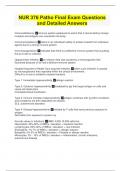Exam (elaborations)
NUR 376 Patho Final Exam Questions and Detailed Answers
- Course
- Institution
Immunodeficiency Immune system weakened to extent that it cannot destroy foreign invaders and antigens can overwhelm the body. Immunocompetence refers to an individual's ability to protect oneself from infectious agents due to a strong immune system. Immunosuppression indicates that there is a de...
[Show more]



